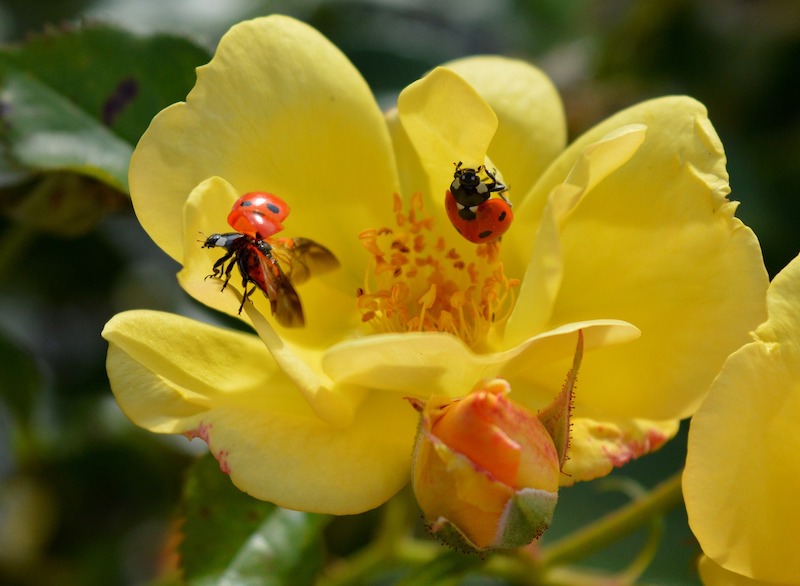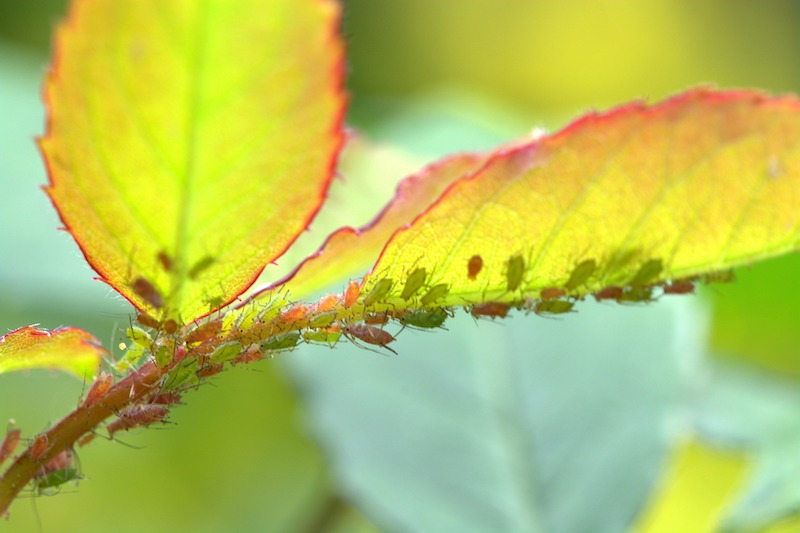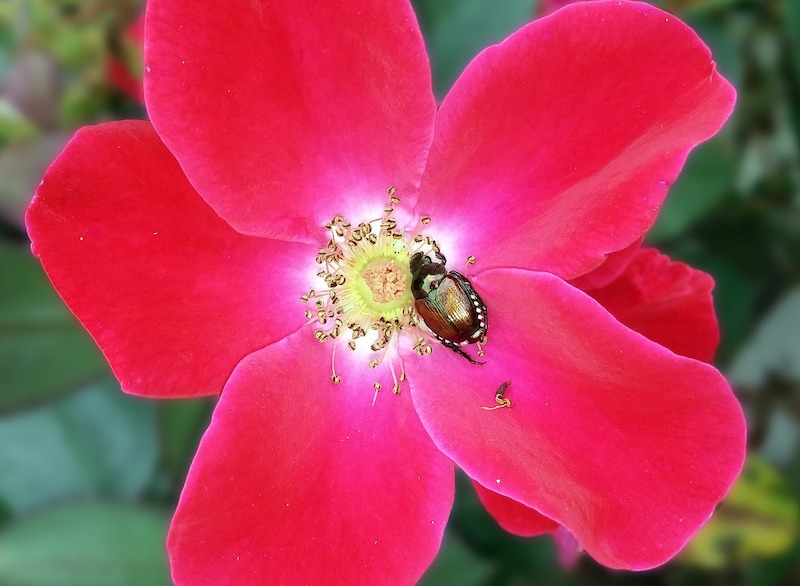Late spring arrives, accompanied by the perfumed aroma of roses; you smile with delight. Then, a few weeks later, after eyeing half-eaten blooms and foliage marred by tiny holes, you reluctantly recall the other beings who relish roses and do your best not to cry.
Joking aside, the reality is that there are hungry bugs, such as aphids, beetles, leafhoppers, mites, and mammals, including deer, rabbits, and squirrels, that appreciate Rosa as much as you. However, by preventing their infestation or controlling it as soon as it starts, you can keep the damage they cause to a minimum and still enjoy your musky blossoms from spring through fall.

Common Rose Pests
Aphids
If you see small green or yellow soft-bodied insects sticking to the undersides of rose’s foliage, then you probably have an aphid problem. The most likely culprit is Macrosiphum rosae. These little bugs suck fluid from the leaves of roses. They also produce a sugary-like substance called honeydew, which attracts a fungus called sooty mold. The appearance of sooty mold often detracts from rose’s typical beauty. Aphid infestation, however, usually does not cause severe damage and is relatively easy to treat.

Treating Aphids on Rose
To treat an infestation of aphids, spray the affected leaves with water and treat with insecticidal soap. You can also use horticultural oils such as neem oil. Prune damaged/dead foliage and throw it away. To prevent future severe infestations, add beneficial insects such as ladybugs (ladybird beetles) and lacewings to your gardens or pots; they will help to control your aphid numbers.
Preventing Aphids on Rose
Healthy plants usually handle unwanted bug infestations better than unhealthy ones, so ensure you support your rose’s health by pruning, watering, and fertilizing appropriately. Other ways to prevent aphids from unleashing havoc in your garden are to use water sprays upon first sight; plant “trap plants’ such as nasturtiums and calendula; introduce beneficial insects such as lacewings and ladybugs (ladybird beetles); and plant aphid repellent plant species including garlic, catnip, and marigolds.
Japanese Beetles
These emerald green and bronze pests consume rose’s fragrant petals and leave you only skeletons of their leaves after ingesting its foliage. Japanese Beetles are rose’s arch nemesis, as they cherish roses. And, when they come, they come in large numbers. They can send signals to others via their pheromones, inviting them to join the rest of the gang, now munching on your formerly pristine blooms. Controlling this particular population can be quite a task, but the prize is worth it.

Treating Beetles on Rose
Japanese beetles are challenging to control. There are, though, many ways to try. The first is to remove them by hand. The second is to use insecticidal soap to try to suffocate them. A third way is to net your roses; by doing so, you will still have intact blooms to cut and bring inside for bouquets, and the fourth way is to use traps. Beware, though, when you use traps, you risk attracting more beetles.
Preventing Beetles on Rose
Beetles often target stressed plants, so keep your rose properly pruned, fertilized, and watered. Other ways of preventing an onslaught of Japanese beetles include introducing beneficial insects such as flower flies and nematodes to your gardens, placing bird baths full of fresh water nearby to attract hungry beetle-eating birds, and planting “trap plants” such as marigold and sweet primrose.
Leafhoppers
Rose leafhoppers, or Edwardsiana rosae, are another sap-sucking bug; they remove valuable plant fluids from the leaves and patches of leaf tissue, leaving pale white areas that can detract from rose’s appearance. Leafhopper damage typically does not harm the plant. It’s more of a cosmetic issue than a health issue.
Treating Leafhoppers on Rose
Spray the rose with water to remove leafhoppers. Prune any dead or damaged foliage and then treat with insecticidal soap or horticultural oil such as neem oil.
Preventing Leafhoppers on Rose
A first line of defense against leafhoppers is introducing their predators, ladybugs (ladybirds) and wasps. You can also “birdify” your gardens by planting bird-friendly species and placing bird baths with fresh water nearby.
Mites
If you walk outside into your rose garden and eye webbing on the foliage, then you have a mite problem. Mites are soft-bodied, arachnid sap suckers; they withdraw life-sustaining fluids from a rose’s foliage. They typically adhere to the undersides of a rose’s foliage but can sometimes be on the topsides. They can cause leaves to turn yellow and brown and drop early.
Treating Mites on Rose
Remove damaged/dead leaves, and then spray with water. Next, treat with a horticultural oil such as neem or insecticidal soap.
Preventing Mites on Rose
Keep your rose healthy to fend off a pest attack, using a proper pruning, watering, and fertilizing regimen. Other than that, spray rose with water early in the mornings to remove any pesky mites, and plant “trap plants” such as chrysanthemums and marigolds.
Critters
Along with apples, blueberries, and hosta, roses rank at the top of your average deer’s grocery list, and there is no part of this ornamental that they won’t try; stems, blooms, buds, and foliage. Rabbits and squirrels find them tasty, too, so do all you reasonably can to deter them.
Treating Critters on Rose
One of the best ways to deter large, hungry mammals is to erect a 6-8-foot fence around your garden. Alternatively, keep several repellents in rotation to deter little critters by scent. Spray the foliage of desirable plants with the repellents weekly and after rain for about a month; then you can reduce the application frequency once the animals “learn” to stay away.
Preventing Critters on Rose
To protect your pristine roses from deer, you have two choices: enclose or repel. If you enclose your rose to protect it, you can build a 6-8-foot fence around your garden or place a net over a potted rose. If you choose to repel deer, you can plant deer-repellent plants such as butterfly bush, garlic, jalapeno, marigold, mint, rosemary, and Russian sage nearby. You can also hang sweaty shirts, soap, and nylons filled with human hair in nearby trees or spread predator urine and pepper spray around the garden.
Rose Pests Chart
|
Pest |
Identifying |
Treating |
|
Aphids |
Small green or yellow soft-bodied insects |
Spray the affected leaves with water and treat with insecticidal soap |
|
Japanese Beetles |
Emerald green and bronze pest |
Remove by hand and suffocate them using insecticidal soap |
|
Leafhoppers |
Small, wedge-shaped insects |
Prune dead or damaged foliage, treat with insecticidal soap or horticultural oil such as neem |
|
Mites |
Soft-bodied, arachnid sap suckers |
Remove damaged/dead leaves, and then spray with water |
|
Critters |
Small animals or creatures |
Erect a 6-8-foot fence around your garden and keep several repellant |
Sources: "Rose Insects and Related Pests." Clemson University Cooperative Extension Service. hgic.clemson.edu
 |
Author Suellen Barnes - Published 4-25-2023 |
